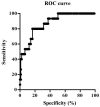Geriatric nutritional risk index predicts surgical site infection after pancreaticoduodenectomy
- PMID: 30155249
- PMCID: PMC6109673
- DOI: 10.3892/mco.2018.1671
Geriatric nutritional risk index predicts surgical site infection after pancreaticoduodenectomy
Abstract
Surgical site infections (SSIs) are a well-known potential complication of surgery. They are assocaited with preoperative malnutrition and lead to increased medical costs and longer hospital stays. Therefore, surgeons should appropriately identify patients who are at a high risk. The geriatric nutritional risk index (GNRI) is a tool, increasingly utilized to assess the degree of malnutrition, particularly in elderly patients. Therefore, the present study attempted to validate whether GNRI could predict the risk of SSI in patients following pancreaticoduodenectomy (PD). A cohort study was retrospectively conducted on 106 patients in the Department of Digestive Surgery, Kawaguchi Municipal Medical Center, Japan from January 2007 to December 2017. All patients were subjected to nutritional screening using GNRI and followed up for the occurrence of postoperative complications, including SSI post PD. Additionally, risk factors for developing SSI, and the patient's height, body mass index and preoperative laboratory values were documented. Patients were divided into SSI (n=15) and non-SSI (n=91) groups with a determined incidence of 14.2% (15/106) for SSI. The results revealed that the SSI group had GNRI values that were significantly reduced compared with the non-SSI group (P<0.001). Receiver operating characteristic curve analysis was performed to determine the cut-off value of GNRI that conferred an increased risk of SSI; it was determined as 94 (sensitivity 80.0%, specificity 83.5%). Univariate analysis confirmed that a GNRI <94 was significantly associated with SSI (P<0.001), whereas multivariate logistic regression analysis revealed that a GNRI <94 was independently associated with SSI following PD (relative risk=1.73, 95% confidence interval=1.23-2.43; P<0.001). Therefore, a GNRI <94 is a potential predictive marker for SSI risk following PD.
Keywords: geriatric nutritional risk index; pancreaticoduodenectomy; surgical site infection.
Figures
Similar articles
-
Geriatric nutritional risk index serves as risk factor of surgical site infection after pancreatoduodenectomy: a validation cohort Ageo study.Gland Surg. 2020 Dec;9(6):1982-1988. doi: 10.21037/gs-20-451. Gland Surg. 2020. PMID: 33447548 Free PMC article.
-
Lower geriatric nutritional risk index predicts postoperative pancreatic fistula in patients with distal pancreatectomy.Mol Clin Oncol. 2020 Feb;12(2):134-137. doi: 10.3892/mco.2019.1960. Epub 2019 Dec 6. Mol Clin Oncol. 2020. PMID: 32002181 Free PMC article.
-
Geriatric Nutritional Risk Index Less Than 92 Is a Predictor for Late Postpancreatectomy Hemorrhage Following Pancreatoduodenectomy: A Retrospective Cohort Study.Cancers (Basel). 2020 Sep 28;12(10):2779. doi: 10.3390/cancers12102779. Cancers (Basel). 2020. PMID: 32998260 Free PMC article.
-
The impact of preoperative nutritional status on postoperative outcomes: an insight from Geriatric Nutritional Risk Index in elderly pancreaticoduodenectomy patients.BMC Surg. 2024 Apr 5;24(1):100. doi: 10.1186/s12893-024-02397-0. BMC Surg. 2024. PMID: 38580988 Free PMC article.
-
Predictive role of preoperative geriatric nutritional risk index for clinical outcomes in surgical gastric cancer patients: A meta-analysis.Front Surg. 2022 Nov 2;9:1020482. doi: 10.3389/fsurg.2022.1020482. eCollection 2022. Front Surg. 2022. PMID: 36406367 Free PMC article. Review.
Cited by
-
Geriatric Nutritional Risk Index as a Screening Tool to Identify Patients with Malnutrition at a High Risk of In-Hospital Mortality among Elderly Patients with Femoral Fractures-A Retrospective Study in a Level I Trauma Center.Int J Environ Res Public Health. 2020 Nov 30;17(23):8920. doi: 10.3390/ijerph17238920. Int J Environ Res Public Health. 2020. PMID: 33266264 Free PMC article.
-
Association Between Geriatric Nutritional Risk Index and Frailty in Older Hospitalized Patients.Clin Interv Aging. 2021 Jun 28;16:1241-1249. doi: 10.2147/CIA.S313827. eCollection 2021. Clin Interv Aging. 2021. PMID: 34234424 Free PMC article.
-
Geriatric nutritional risk index serves as risk factor of surgical site infection after pancreatoduodenectomy: a validation cohort Ageo study.Gland Surg. 2020 Dec;9(6):1982-1988. doi: 10.21037/gs-20-451. Gland Surg. 2020. PMID: 33447548 Free PMC article.
-
Lower geriatric nutritional risk index predicts postoperative pancreatic fistula in patients with distal pancreatectomy.Mol Clin Oncol. 2020 Feb;12(2):134-137. doi: 10.3892/mco.2019.1960. Epub 2019 Dec 6. Mol Clin Oncol. 2020. PMID: 32002181 Free PMC article.
-
A scoring system to predict the risk of major complications after laparoscopic liver resection in elderly patients with hepatocellular carcinoma.Surg Endosc. 2022 Oct;36(10):7756-7763. doi: 10.1007/s00464-022-09303-w. Epub 2022 May 9. Surg Endosc. 2022. PMID: 35534739
References
-
- Kimura W, Miyata H, Gotoh M, Hirai I, Kenjo A, Kitagawa Y, Shimada M, Baba H, Tomita N, Nakagoe T, et al. A pancreaticoduodenectomy risk model derived from 8575 cases from a national single-race population (Japanese) using a web-based data entry system: The 30-day and in-hospital mortality rates for pancreaticoduodenectomy. Ann Surg. 2014;259:773–780. doi: 10.1097/SLA.0000000000000263. - DOI - PubMed
-
- Ahmad SA, Edwards MJ, Sutton JM, Grewal SS, Hanseman DJ, Maithel SK, Patel SH, Bentram DJ, Weber SM, Cho CS, et al. Factors influencing readmission after pancreaticoduodenectomy: A multi-institutional study of 1302 patients. Ann Surg. 2012;256:529–537. doi: 10.1097/SLA.0b013e318265ef0b. - DOI - PubMed
-
- DeOliveira ML, Winter JM, Schafer M, Cunningham SC, Cameron JL, Yeo CJ, Clavien PA. Assessment of complications after pancreatic surgery: A novel grading system applied to 633 patients undergoing pancreaticoduodenectomy. Ann Surg. 2006;244:931–939. doi: 10.1097/01.sla.0000246856.03918.9a. - DOI - PMC - PubMed
LinkOut - more resources
Full Text Sources
Other Literature Sources

